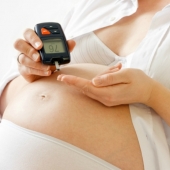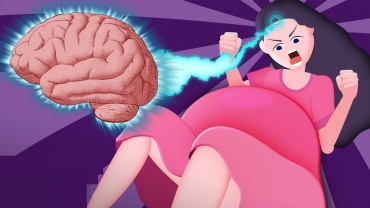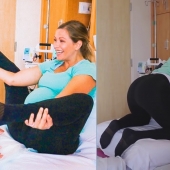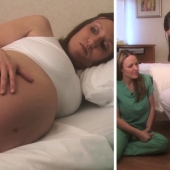
You may try several of these positions during the second stage of your labor. Consider trying them out at home, before labor starts, as well. Don't actually push or bear down as you "practice" a position, but simply get into each position and maintain it for the length of a contraction (about 60-70 seconds), consider what support you need to get into the position, where pillows and hands of helpers can support you most effectively, and how you would assume a position of rest and relaxation after the contraction is over.
The position of your body is important as you push. Notice in each position that the mother is curved forward, and that her head is down. Curling forward and tucking your chin helps the baby to navigate the curves of the pelvis. Arching your back and neck is much less helpful to this process. In many positions, notice that the mother has grasped her legs behind her knees and pulls her legs back. When doing this, it is most effective if your elbows are out, as if you were rowing a boat. If others help support your legs, they should merely support them, not force them back or apart. These position adjustments are things that your birth partner(s) can remind you of as you push.
Birthing Bar
A birthing bar is an attachment that can be added to most labor beds to help facilitate a squatting position. The squatting position helps to expand the size of your pelvis, and uses gravity to promote the downward movement of your baby. When using the bar, the foot of the bed can be dropped, and the head of the bed raised high. Between contractions, you can sit, supported by the head of the bed, and then during contractions, move forward to squat, supported by the bar.
There is an alternative way to use the birthing bar. The vertical supports of the bar are used to rest your feet, and a sheet or towel is looped over the top of the bar. During the contractions, you grasp and pull back on the sheet as you push downward. This alternative might be helpful if you are too short to be comfortably supported by the bar in the squatting position or if you have had an epidural and your legs are too numb to safely support you in a squatting position.
Birthing Stool
A birthing stool can help you push in a very familiar position: the position you are used to using for having a bowel movement. Additionally, the low height of the stool flexes your legs and expands the size of your pelvis, and the upright position helps use gravity to promote the downward movement of the baby. You would push in the position shown, and then between contractions can lean backward to rest supported by your partner
.
Sitting Upright
This upright sitting position is a variation on the use of a birthing stool. Notice how the mother is curled forward around her baby, with her elbows out as she pushes. The head of the bed is raised high, and the foot of the bed is lowered, giving you a place to place your feet. Like the use of the stool, this position helps you use gravity effectively. Between contractions, you can lean backward supported by the bed. If you like, your partner can also sit behind you in bed as you use this position
.
Kneeling
While pushing or giving birth on your knees may be used by any woman, it may be especially effective if you have had back pain during labor, as it helps to encourage movement of the baby. During the contraction, you flex your hips and lower your buttocks slightly as you push. Between contractions, you can drape yourself over the head of the bed to rest and relax. You may try this position on your hands and knees, but, as your wrists may quickly become tired of supporting your body, you may find it easier to rest on your forearms as illustrated by this mother. In an alternative to this position, you may drape your upper body over a birthing ball.
Semi-Seated, with Support
This position is not as effective in opening the pelvis as the upright positions illustrated above, but is probably the most common position used for the actual birth of baby - not necessarily because it is the best position for birth but, as you can imagine, it is the most convenient position for your doctor or midwife. In this illustration, notice that the head of the bed is raised to at least 30 degrees or greater, and that the mother has a pillow placed under her right hip, helping her turn slightly to the left. These adjustments help keep the weight of her uterus and baby from interfering with blood flow through the vessels that flow behind them. Notice also that she is curled forward around her baby, holding behind her knees, and that her support people are merely supporting her legs and her upper back, not pushing on them.
The side-lying position is especially useful in promoting rest and relaxation between pushing contractions. Some research suggests that this is the most effective birthing position for preventing tears.
- 2602 views













